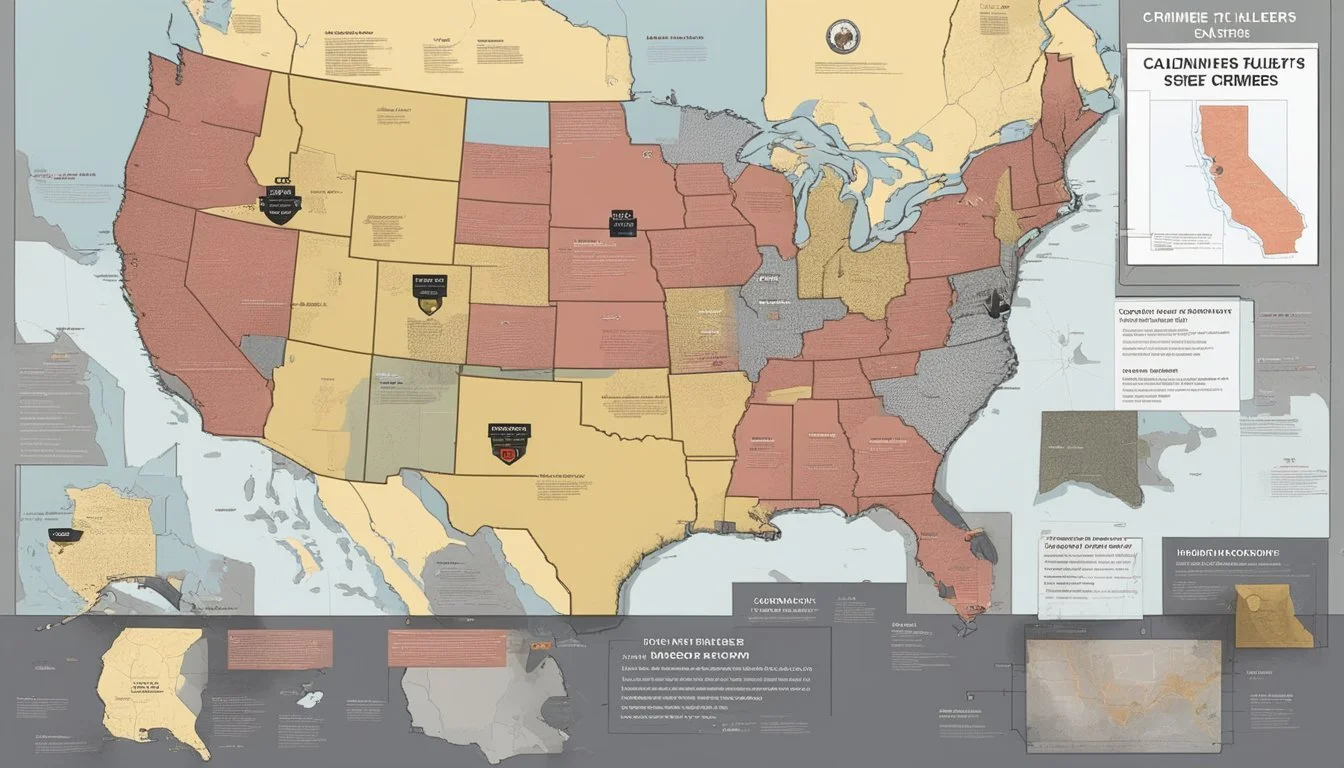Jeffrey Cutlip: 6 Cold Case Breakthroughs That Finally Brought the Killer to Justice
Decades-Old Murders Solved
Jeffrey Cutlip's case stands as a chilling example of cold case investigations that spanned decades. The Portland, Oregon serial killer's crimes went unsolved for many years, leaving victims' families without closure and a community on edge.
Advancements in forensic technology and persistent detective work ultimately led to breakthroughs in Cutlip's case. These developments shed light on murders committed between 1975 and 1993, demonstrating the power of modern investigative techniques in solving long-dormant cases. The resolution of Cutlip's crimes offers a compelling look at the evolving nature of criminal investigations and the pursuit of justice.
1) The Golden State Killer
Joseph James DeAngelo Jr., known as the Golden State Killer, terrorized California from 1974 to 1986. He committed at least 13 murders, 50 rapes, and 120 burglaries across the state.
For decades, the case remained unsolved despite extensive investigations. In 2018, a breakthrough finally came through the use of genetic genealogy.
Investigators uploaded the killer's DNA profile to a public genealogy database. This led them to distant relatives of the suspect, allowing them to narrow down their search.
On April 24, 2018, authorities arrested DeAngelo at his home in Sacramento County. The arrest marked the end of a 40-year manhunt and brought relief to countless victims and their families.
In 2020, DeAngelo pleaded guilty to 13 counts of first-degree murder and 13 kidnapping-related charges. He received multiple life sentences without the possibility of parole.
The Golden State Killer case demonstrated the power of genetic genealogy in solving cold cases. It paved the way for similar techniques to be used in other long-unsolved crimes.
2) The Zodiac Killer's Cipher Solved
The Zodiac Killer's infamous Z340 cipher remained unsolved for over 51 years, baffling investigators and cryptographers alike. This 340-character code was sent to The San Francisco Chronicle on November 8, 1969, as part of a series of taunting messages from the unidentified serial killer.
In December 2020, a team of amateur code breakers achieved a major breakthrough. They successfully cracked the Z340 cipher, revealing its chilling contents. The decoded message provided insights into the killer's mindset but did not disclose their identity.
This achievement followed the earlier decryption of a 408-character cipher in 1969, which was solved within a week of its receipt. The Z340 proved far more challenging, resisting decades of attempts by both professionals and amateurs.
The solution to the Z340 cipher was verified by the FBI's Cryptanalysis and Racketeering Records Unit. This breakthrough reignited interest in the case and sparked hope for potential new leads in identifying the Zodiac Killer.
While the cipher's decryption marked a significant milestone, the Zodiac Killer's identity remains unknown. The case continues to captivate public interest and challenge law enforcement, with ongoing efforts to solve the remaining puzzles left behind by this elusive criminal.
3) The Capture of BTK Killer
The BTK Killer terrorized Wichita, Kansas for decades, evading capture and taunting authorities with cryptic messages. Dennis Rader, the man behind the BTK moniker, committed at least 10 murders between 1974 and 1991.
Rader's downfall began when he resumed communication with law enforcement in 2004, after years of silence. He sent a series of letters and packages containing evidence from his crimes, believing he could not be traced.
In 2005, investigators received a floppy disk from BTK. Forensic analysis revealed metadata linking the disk to Christ Lutheran Church and a user named Dennis. This crucial piece of evidence led police to Dennis Rader.
Authorities gathered DNA evidence from Rader's daughter's medical records, which matched DNA found at crime scenes. On February 25, 2005, Dennis Rader was arrested while driving near his home in Park City, Kansas.
Rader pleaded guilty to 10 counts of first-degree murder on June 27, 2005. He was sentenced to 10 consecutive life terms in prison, with a minimum of 175 years before eligibility for parole.
4) The Green River Killer's DNA Breakthrough
The Green River Killer case saw a major breakthrough in 2001 when DNA evidence finally led to the arrest of Gary Leon Ridgway. For nearly two decades, the serial killer had eluded capture despite an extensive investigation.
Advances in DNA technology allowed investigators to reexamine evidence collected in the 1980s. A saliva sample Ridgway provided in 1987 was matched to DNA found on several victims using newly developed techniques.
This genetic evidence directly linked Ridgway to the crimes and provided probable cause for his arrest. On November 30, 2001, police took Ridgway into custody at his workplace.
The DNA match proved crucial in building the case against Ridgway. He ultimately pleaded guilty to 48 counts of aggravated first-degree murder in 2003, though he is suspected in many more deaths.
This breakthrough demonstrated the power of preserving evidence and revisiting cold cases as forensic capabilities improve. It brought long-awaited answers and closure to victims' families after years of uncertainty.
5) The Grim Sleeper Identified
The Grim Sleeper terrorized Los Angeles for decades, claiming at least 10 victims between 1985 and 2007. This serial killer targeted young African American women, many of whom were involved in prostitution or drug use.
For years, the case remained unsolved despite extensive police efforts. The killer's method of long periods of inactivity between murders earned him the moniker "Grim Sleeper."
In 2010, a breakthrough finally came through DNA evidence. Investigators used a technique called familial DNA searching, which identified a partial match to a convicted felon named Christopher Franklin.
This led police to Christopher's father, Lonnie David Franklin Jr. Undercover officers collected DNA samples from Franklin, which matched evidence from the crime scenes.
On July 7, 2010, police arrested Lonnie Franklin Jr. as the suspected Grim Sleeper. The evidence against him was substantial, including DNA matches and ballistics linking him to the murders.
Franklin's trial began in February 2016. Prosecutors presented overwhelming forensic evidence connecting him to the crimes. In May 2016, a jury found Franklin guilty of 10 counts of murder and one count of attempted murder.
6) The Unmasking of Jack Unterweger
Jack Unterweger, an Austrian crime journalist, led a double life as a brutal serial killer. He gained fame as a "reformed" criminal and respected writer, using this cover to carry out multiple murders.
Unterweger's crimes spanned continents, including three killings in Los Angeles. His ability to blend into society and report on the very murders he committed allowed him to evade suspicion for years.
In 1991, Unterweger visited Los Angeles on assignment from Austrian media. This trip coincided with a series of murders that bore similarities to his previous crimes.
Law enforcement eventually connected the dots, linking Unterweger to numerous unsolved cases. His carefully crafted persona as a rehabilitated offender crumbled under scrutiny.
The unmasking of Jack Unterweger shocked the public and law enforcement alike. It exposed the dangers of assuming rehabilitation without thorough investigation and ongoing monitoring.
Unterweger's case serves as a stark reminder that appearances can be deceiving. It highlights the importance of vigilance and thorough investigation in solving cold cases and preventing future crimes.
Overview of Jeffrey Cutlip's Criminal History
Jeffrey Cutlip's criminal career spanned decades, leaving a trail of violence across Portland, Oregon. His actions deeply impacted local communities and posed significant challenges for law enforcement.
Early Criminal Activities
Jeffrey Cutlip's criminal behavior began in the 1970s. He committed his first known murder in 1975, killing Marlene Carlson in the apartment building where they both lived.
In 1977, Cutlip was convicted of sodomy and served time in prison. After his release, he continued his criminal activities.
Cutlip murdered a teenage girl in 1993, demonstrating an escalation in his crimes. He evaded capture for these killings for many years.
Throughout this period, Cutlip was in and out of prison for various offenses. His criminal record included sexual crimes and other violent acts.
Impact on the Communities
Cutlip's crimes created fear and uncertainty in Portland neighborhoods. His ability to avoid detection for decades left residents feeling vulnerable.
Local law enforcement faced significant challenges in solving these cold cases. The lack of closure for victims' families added to the community's distress.
When Cutlip finally confessed in 2012, it brought relief to many. His admission solved three long-standing murder cases, providing answers to grieving families.
The revelation of Cutlip as a serial killer shocked the Portland community. It highlighted the persistence of cold case detectives in pursuing justice for victims.
Forensic Advances in Cold Case Investigations
Technological breakthroughs have revolutionized cold case investigations. DNA analysis and comprehensive crime databases now provide powerful tools for solving long-unsolved crimes.
Role of DNA Technology
DNA profiling has become a game-changer in cold case investigations. Advanced techniques like Y-STR and mitochondrial DNA analysis allow for extraction of genetic material from degraded samples. These methods can identify suspects from decades-old evidence.
Familial DNA searches expand the pool of potential matches by looking for partial genetic similarities. This technique has solved numerous high-profile cold cases in recent years.
Next-generation sequencing enables analysis of mixed DNA samples, crucial for complex crime scenes. It can separate individual profiles from evidence containing genetic material from multiple people.
Importance of Modern Crime Databases
Centralized digital databases have transformed how investigators access and analyze case information. The Combined DNA Index System (CODIS) allows for rapid comparison of DNA profiles across jurisdictions.
Automated fingerprint identification systems can quickly search millions of prints. This technology has revived cases where traditional methods failed to find matches.
Facial recognition software assists in identifying suspects from old photographs or video footage. It can generate leads by comparing images to large databases of mugshots and ID photos.
Ballistics databases like NIBIN help link firearms evidence across cases. This can reveal connections between seemingly unrelated crimes, potentially uncovering serial offenders.
Legal Proceedings and Conviction
Jeffrey Cutlip's legal proceedings began in 2013 after he confessed to three murders committed between 1975 and 1993. The case revealed important implications for cold case investigations and justice for victims' families.
Trial Phases
Cutlip pleaded guilty to three homicides in Portland, Oregon in 2013. The trial phase was relatively short due to his confession. Prosecutors presented evidence linking Cutlip to the murders of Marlene Carlson, Julie Bennett, and Nielen Pedersen.
DNA evidence and Cutlip's detailed confessions played crucial roles in the proceedings. The court heard testimony from victims' family members, detectives who worked on the cold cases, and forensic experts.
Sentencing and Legal Ramifications
In 2014, Cutlip was sentenced to life in prison for his crimes. The judge considered the severity of the offenses and Cutlip's history as a predatory sex offender when determining the sentence.
This case highlighted the importance of preserving evidence in cold cases. It also demonstrated the value of advances in DNA technology for solving decades-old crimes.
Cutlip's conviction brought closure to the victims' families after years of uncertainty. The legal outcome reinforced the commitment of law enforcement to pursue justice in unsolved cases, regardless of the passage of time.







